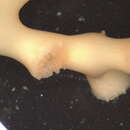Comprehensive Description
provided by Smithsonian Contributions to Zoology
Madrepora oculata Linnaeus, 1758
Madrepora oculata.—Marenzeller, 1904b:79.—Durham, 1966:127.—Zibrowius, 1974a:762–766 [discussion and synonymy].—Cairns, 1979: 39–42 [discussion and synonymy]; 1982:15 [discussion and synonymy].
Madrepora galapagensis Vaughan, 1906:63–64, pl. 1: fig. 2, pl. 2: fig. 1, lb.—Durham and Barnard, 1952:11.—Durham, 1962:46; 1966:125—Wells, 1983:234, pl. 13: figs. 1, 2.
- bibliographic citation
- Cairns, Stephen D. 1991. "A revision of the Ahermatypic Scleractinia of the Galapagos and Cocos Islands." Smithsonian Contributions to Zoology. 1-32. https://doi.org/10.5479/si.00810282.504
Comprehensive Description
provided by Smithsonian Contributions to Zoology
Madrepora oculata Linnaeus, 1758
Madrepora oculata Linnaeus, 1758:798.—Marenzeller, 1904b:79.—Durham and Barnard, 1952:11.—Eguchi, 1968:C29. pl. C8: figs 1–9.—Zibrowius, 1974a:762–766, pl. 2: figs. 3–5 [synonymy].—Cairns, 1979:39–42, pl. 3: fig. 2, pl. 4: fig. 5; pl. 5: figs. 1–3 [synonymy]; 1982:15, pl. 3: figs. 4–6 [synonymy]; 1984:10, pl. 1: fig. H; 1991a:9–10, pl. 2: fig. j; pl. 3: figs, a-d.—Zibrowius, 1980:36–40, pl. 13: figs. A-P [synonymy].
Madrepora galapagensis Vaughan, 1906b:63–64, pl. 1: fig. 2; pl. 2: figs. 1, 1b.—Durham and Barnard. 1952:11.—Wells, 1983:234, pl. 13: figs. 1, 2.
Madrepora (Sclerhelia) sp.—Eguchi, 1938, table 2.
Madrepora (Amphelia) sp.—Yabe and Eguchi, 1941b: 102.
Madrepora cf. oculata.—Eguchi, 1942:136–137, pl. 6: fig. 1.
DESCRIPTION OF NORTHEAST PACIFIC SPECIMENS.—Colonies uniplanar, formed by closely spaced extratentacular sympodial budding. Calices circular and 3.0–3.7 mm in diameter, exsert on end branches but flush or recessed into coenosteum on larger diameter branches. Coenosteum faintly striate and finely granular; light brown in color.
Septa hexamerally arranged in 3 complete cycles (24 septa) according to the formula: S1–2 >> S3. S12 not exsert and have slightly sinuous inner edges that fuse with the columella. S3 rudimentary. Fossa deep and relatively broad. Columella a bolus of trabeculae, interconnected to lower, inner edges of S1–2.
- bibliographic citation
- Cairns, Stephen D. 1994. "Scleractinia of the temperate North Pacific." Smithsonian Contributions to Zoology. i-150. https://doi.org/10.5479/si.00810282.557.i
Comprehensive Description
provided by Smithsonian Contributions to Zoology
Madrepora oculata Linnaeus, 1758
ACCOUNT.—See Part 1.
Cyathelia Milne Edwards and Haime, 1849
DIAGNOSIS.—Colonies arborescent, formed by regular, alternate, extratentacular budding. Coenosteum dense and faintly costate. Well-developed pali occur before first three septal cycles; columella papillose.
TYPE SPECIES.—Madrepora axillaris Ellis and Solander, 1786, by monotypy.
Cyathelia axillaris (Ellis and Solander, 1786)
Madrepora axillaris Ellis and Solander, 1786:153, pl. 13: fig. 5.
Cyathelia axillaris.—Milne Edwards and Haime, 1850b:72–73.
Cyathohelia axillaris.—Milne Edwards and Haime, 1857:110–111.—Duncan, 1876:438.—Alcock, 1898:28.—Bedot, 1907:145, pl. 15: fig. 103.
Cyathelia cf. axillaris.—Eguchi, 1942:138 (142), pl. 6: figs. 2, 3 [synonymy].
Cyathelia axillaris.—Eguchi, 1968:C28, pl. C20: figs, 5–7; pl. C24: figs. 4, 5 [synonymy].—Kikuchi, 1968:8, pl. 5: fig. 1.
DESCRIPTION.—Coralla sparsely branched, resulting in small, robust, bushy colonies, the largest known about 7.5 cm in height, supporting approximately 100 corallites (Eguchi, 1968, pl. C24: fig. 4). Branching is essentially sympodial, but two buds often originate on opposite sides of a terminal corallite, the parent corallite ultimately becoming immersed in thick coenosteum within the branch axil. Corallites circular when small, often becoming elliptical or even medially constricted if located at a branch axil. Corallites relatively large, up to 11 mm in GCD. Branch coenosteum dense, granular, light brown to tan in color, and usually faintly costate. Corallites often pigmented a darker shade of brown.
Septa usually hexamerally arranged in 4 cycles; however, small corallites (i.e., <8.5 mm in GCD) often lack several pairs of S4 from lateral septal systems, whereas larger corallites (i.e., >10 mm GCD) sometimes have an extra (13th) half-system for a total of 52 septa. Septal formula: S1–2S3>S4, >S1–2 up to 1.5 mm exsert, quite thick, and have straight inner edges reaching about one-fourth distance into fossa. S3 equally exsert but only about two-thirds as wide as S1–2. S4 less exsert and about 80% width of the S3. Twelve thick pali, each about 1.5 mm wide, form a palar crown encircling columella. Another crown of 12 P3, each palus of equal width but slightly thicker than P1–2, occurs slightly recessed from the columella and slightly higher in fossa. Pali and septal faces highly granular. Columella papillose.
- bibliographic citation
- Cairns, Stephen D. 1994. "Scleractinia of the temperate North Pacific." Smithsonian Contributions to Zoology. i-150. https://doi.org/10.5479/si.00810282.557.i

